Louisiana’s location on the Gulf of Mexico brings many different species of waterfowl to the state’s shores every year.
According to Audubon Louisiana, more than 470 bird species have been recorded within the borders of the Pelican State. A list of some of the common ones you may see can be found here.
Now, let’s get to some of the ducks within the state and its border waters. There may be others that are sometimes found in Louisiana, but these are the most commonly sighted.
Most measurements below are according to the Cornell Lab of Ornithology’s All About Birds, which provides in-depth identification resources and fact pages for every species of North American bird. The whistling duck measurements are from the Tennessee Wildlife Resources Agency.
Whistling Ducks
Fulvous Whistling-duck
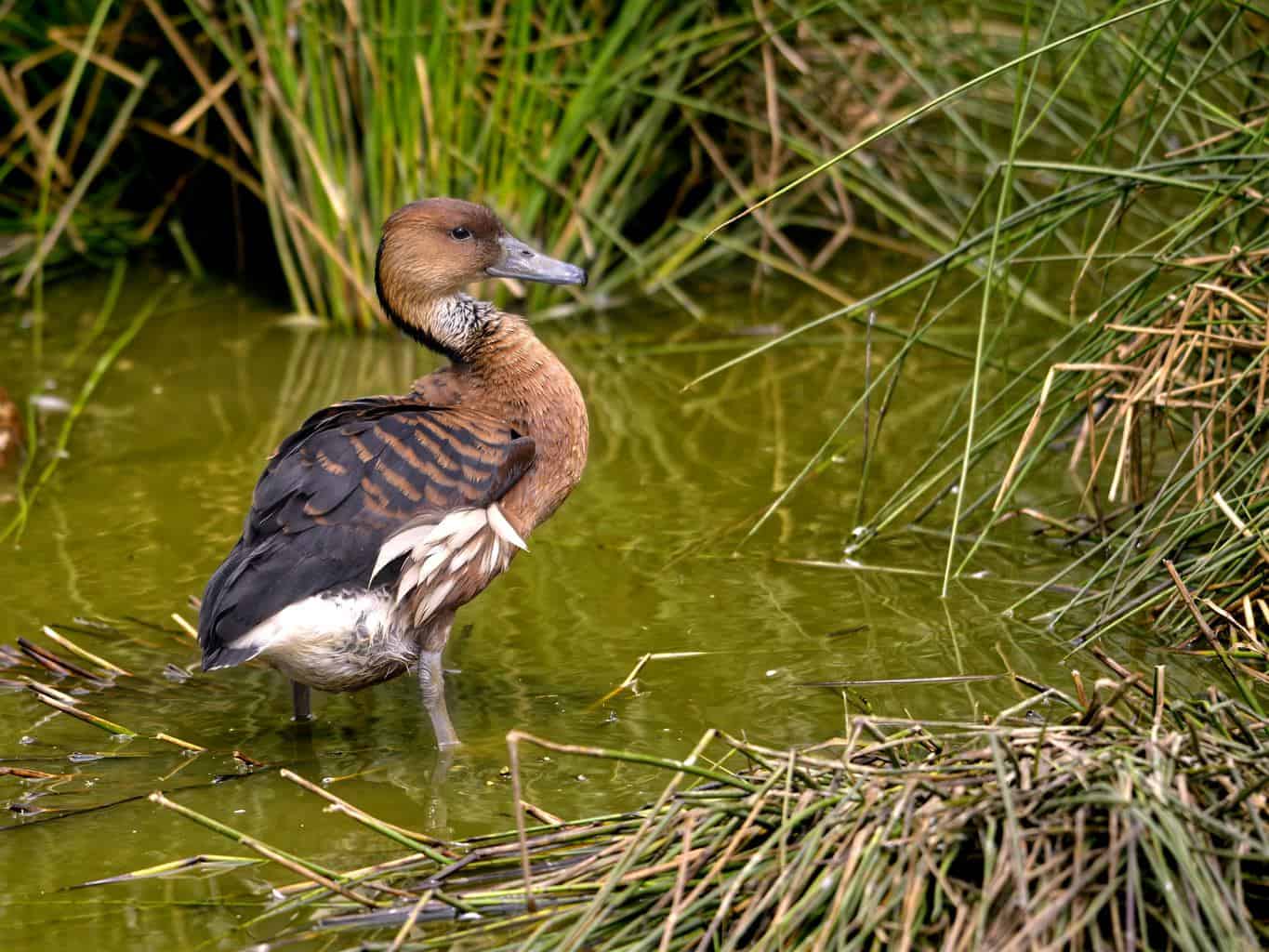
- Dendrocygna bicolor
- Length: 19 inches
- Weight: 16-24 ounces
- Wingspan: 29 inches
Whistling ducks are long-legged, long-necked ducks. The fulvous whistling-duck has about the same body size as the average duck, but with a longer neck and legs.
They have cinnamon-brown sides and heads, with black barring on their backs and white striping on their sides. Their bills, feet, and legs may range from gray to blue.
This interesting bird’s breeding range extends into southwestern Louisiana, where they can be found in wetlands, ponds, and rice fields near the Gulf Coast from the spring to the fall.
Among common sighting areas from eBird users are Lacassine National Wildlife Refuge, Cameron Prairie National Wildlife Refuge, and Anahuac National Wildlife Refuge.
Black-bellied Whistling-duck
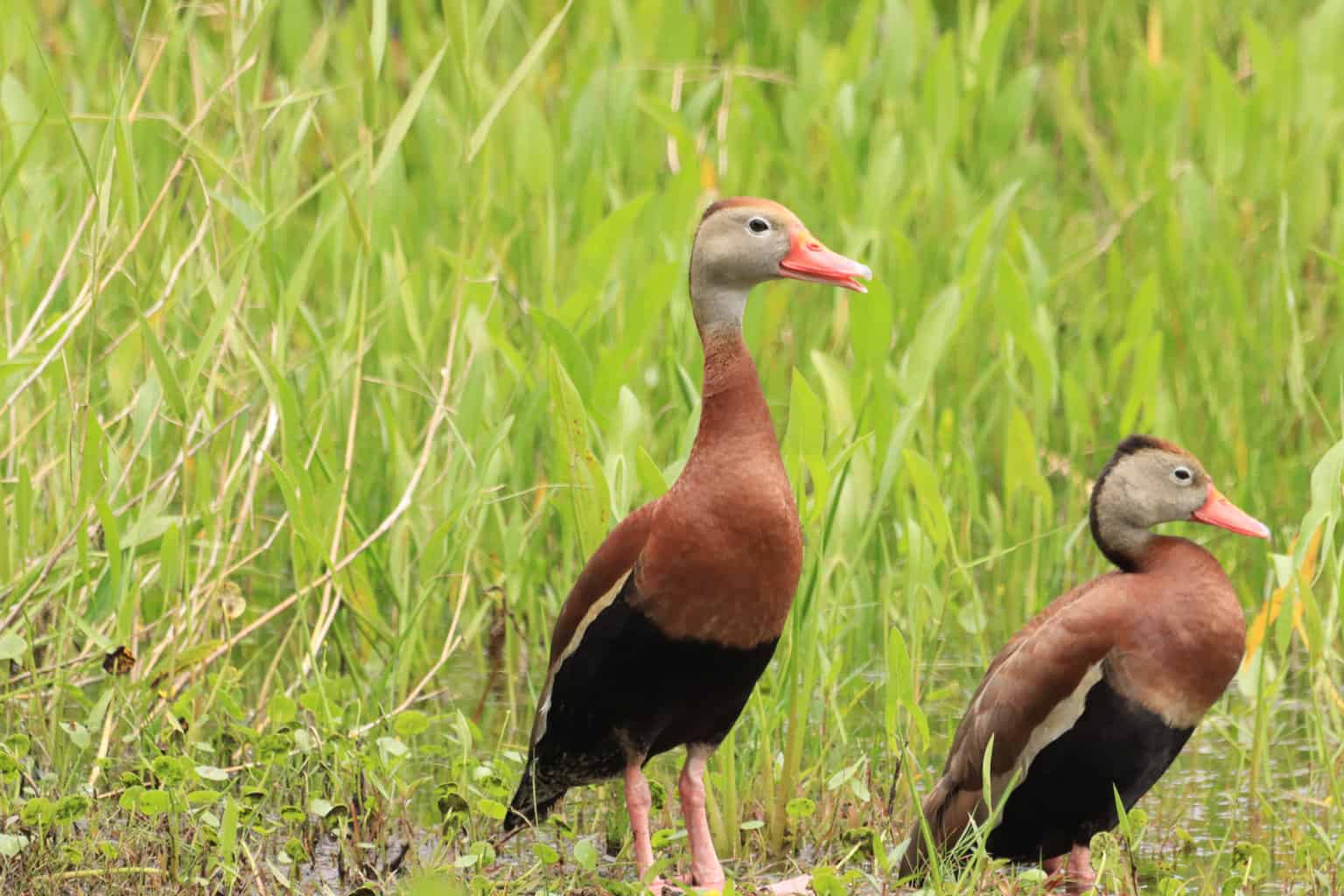
- Dendrocygna autumnalis
- Length: 19 inches
- Weight: 16-24 ounces
- Wingspan: 30 inches
The black-bellied whistling-duck can be distinguished from the fulvous whistling-duck by its coloring.
The black-bellied whistling-duck, as its name implies, has a black belly that meets a rich brown neck, with that brown spilling over to the bird’s topside.
The species’ light gray face and red bill are also notable, as is a white wing patch, visible as a stripe along its side when on the ground and larger when in the air.
This is a species well-adapted to human areas, according to the Cornell Lab of Ornithology’s All About Birds.
Black-bellied whistling-ducks may reside anywhere from agricultural fields to city parks and golf courses. This has allowed them to adjust to life in the United States as their range extends north from Mexico and Central America.
True to this, some of the most common places people spot them in Louisiana are in parks in Baton Rouge, one of the state’s most populous cities, according to eBird reports.
They’re cavity nesters, so look out for them in nest boxes and trees near ponds and rice fields.
Dabbling Ducks
Wood Duck
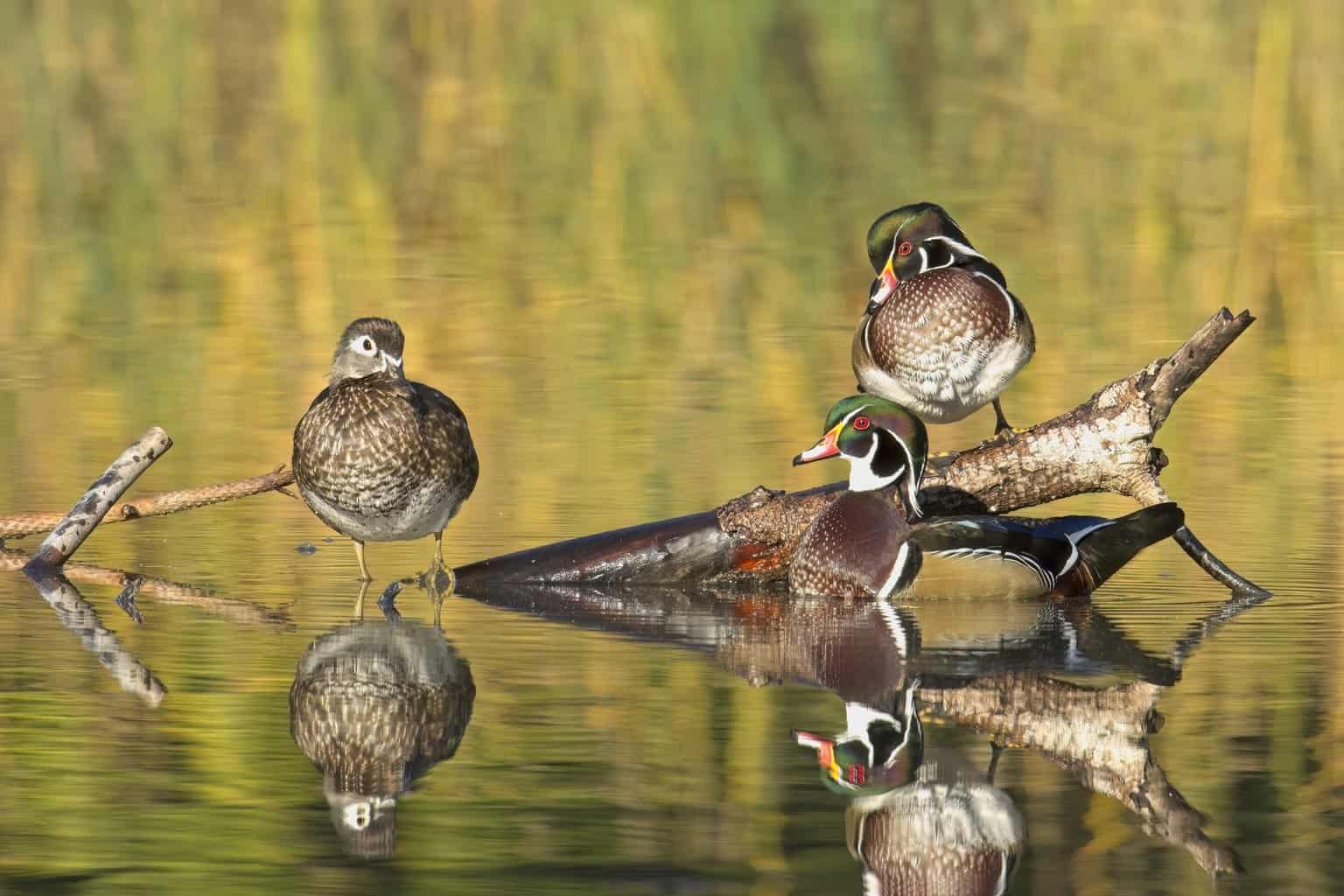
- Aix sponsa
- Length: 18.5-21.3 inches
- Weight: 16-30.4 ounces
- Wingspan: 26-28.7 inches
If you can clearly distinguish the wood duck’s crest, you can easily identify this unique bird. The male wood duck sports a green head that meets a rich brown chest with crisp white and black markings on its neck.
Female wood ducks’ colors aren’t quite as bold, but they still have an identifiable crest on the back of their grayish head. They have a white patch around their eyes, with a slightly more brown body. Blue and white coloring on the wings may also be visible in flight.
Look for wood ducks near wooded lakes and rivers. As cavity nesters, wood ducks lay their eggs in the holes of trees, so they need enough trees surrounding the water to provide cover and suitable habitat.
If you put up a nest box near the water’s edge in the eastern United States, the wood duck is often the most likely duck species to utilize it.
Mallard
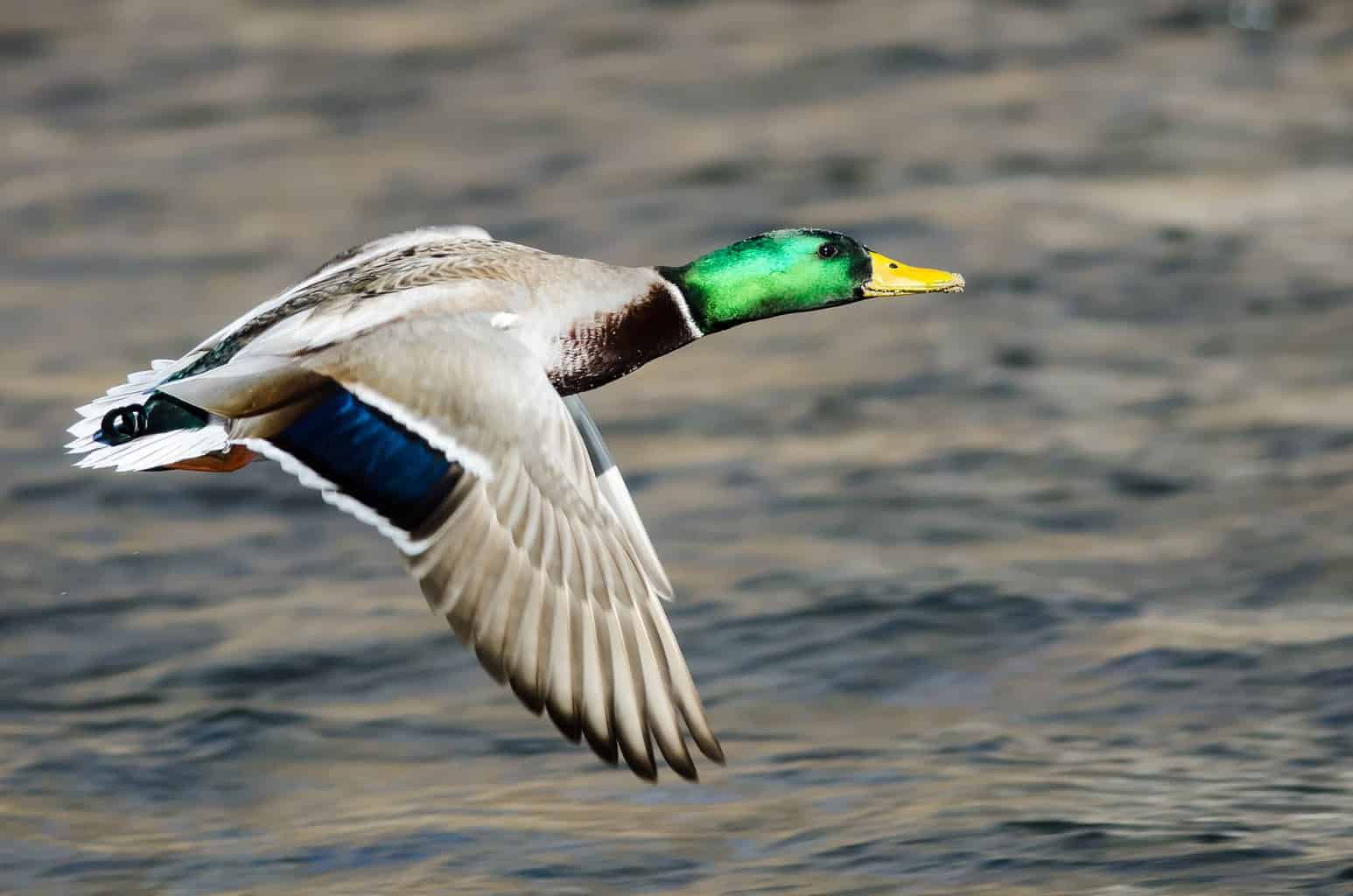
- Anas platyrhynchos
- Length: 19.7-25.6 inches
- Weight: 35.3-45.9 ounces
- Wingspan: 32.3-37.4 inches
No matter where you live in North America, you have probably seen at least a couple of mallards, one of the bird species most easily observable and most comfortable with humans’ presence.
These birds may be observed nesting in backyards and feeding at common human-populated areas, such as local parks, schools, and roadsides.
You can recognize a male mallard by its iridescent metallic green head and contrasting yellow bill. Females don’t have the iconic green head, but they’re often spotted at the same time as males in groups of two or more.
Females look similar to other surface-feeding ducks in the Anas genus. They have dull orange bills spotted in black.
Mottled Duck
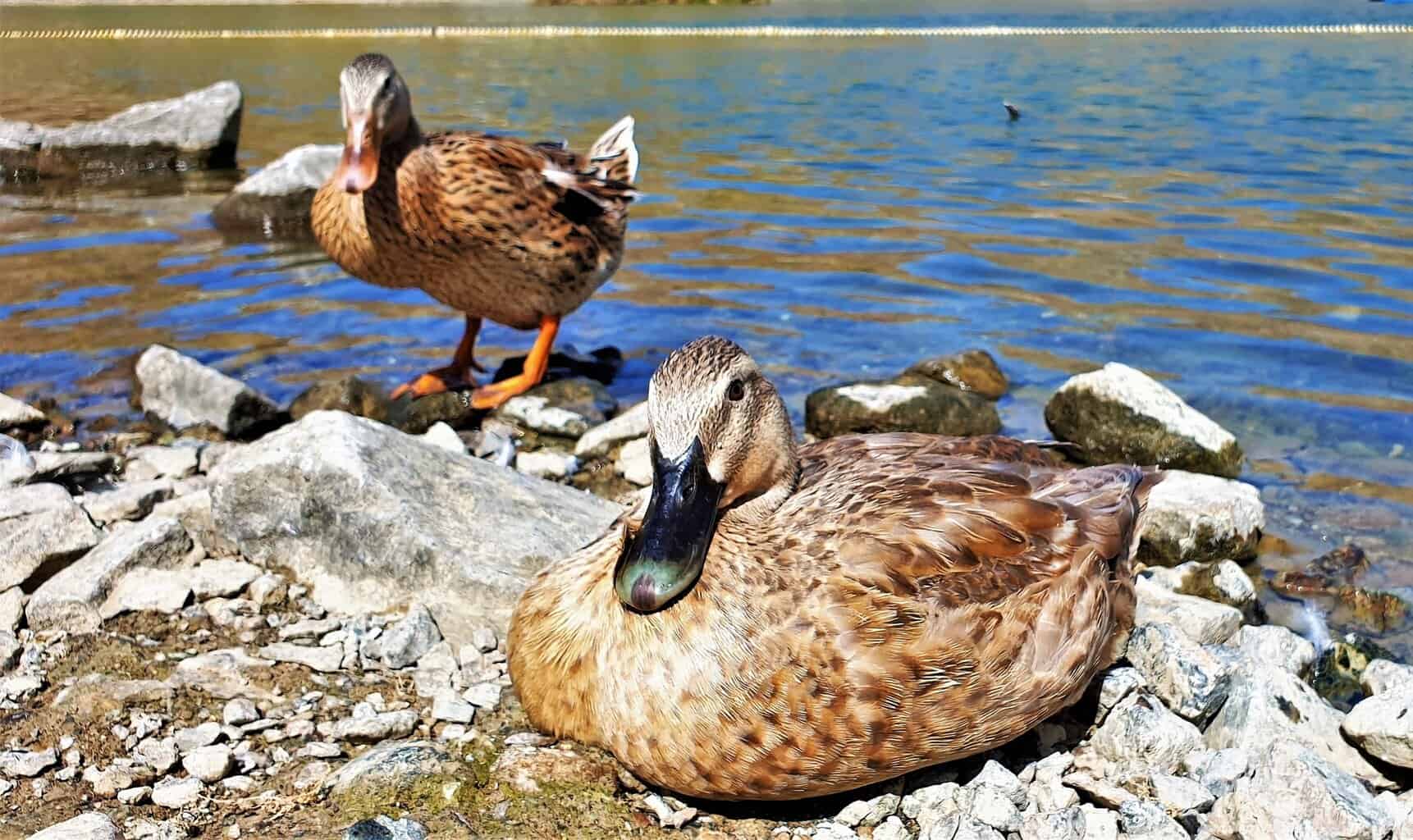
- Anas fulvigula
- Length: 18.5-22.5 inches
- Weight: 24.7-43.8 ounces
- Wingspan: 31.5-34.3 inches
Mottled ducks look very similar to females in the Anas genus. Think of the mottled duck like a female mallard, except with darker tinted main plumage and an absence of any white tail feathers or black markings on its bill.
They have a fairly restricted range compared to many North American duck species, but that year-round range does include much of southern Louisiana, including the state’s whole coastline.
Look for them at wildlife refuges, lakes, flooded agricultural fields, and marshes along and near the coast.
American Black Duck
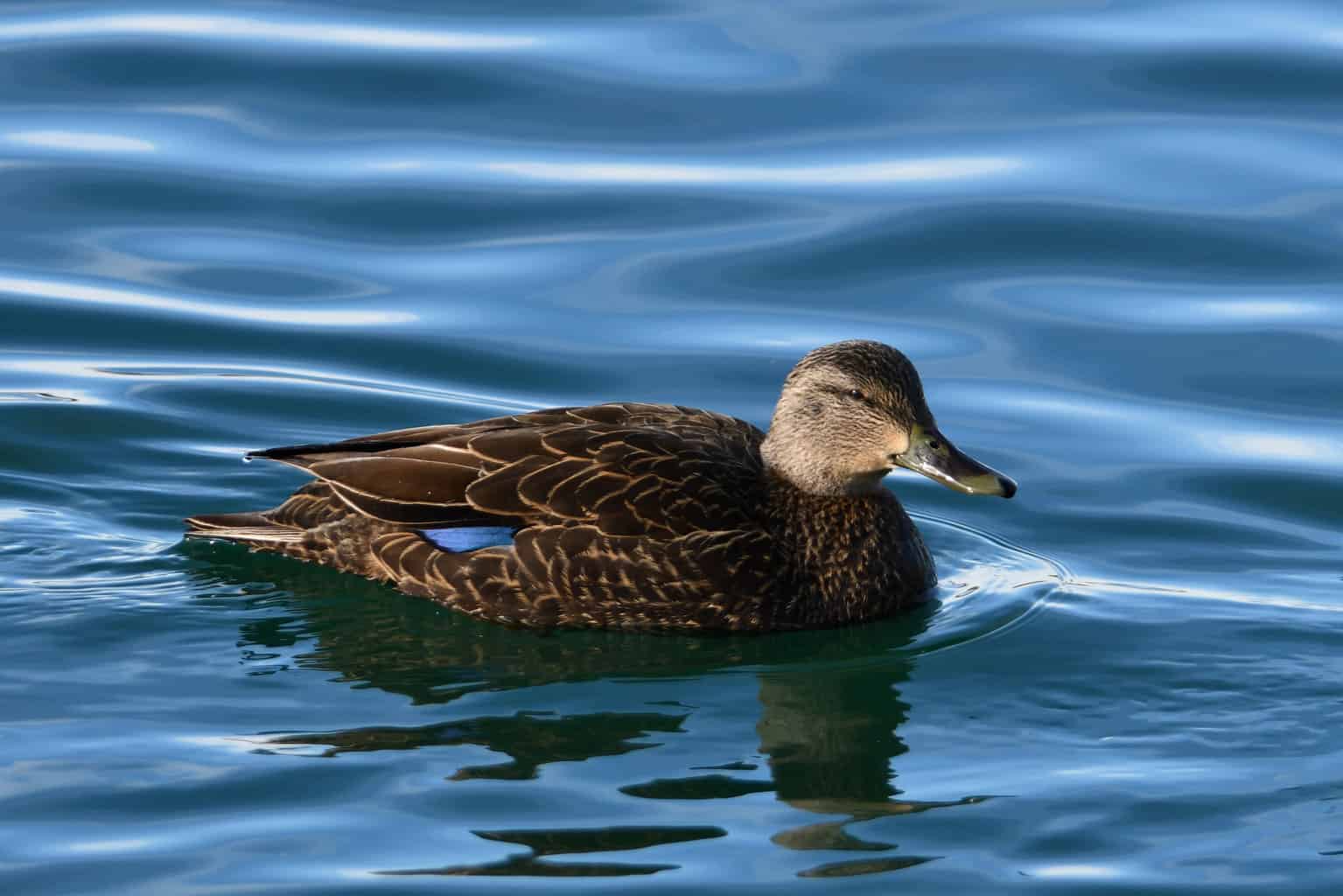
- Anas rubripes
- Length: 21.3-23.2 inches
- Weight: 25.4-57.9 ounces
- Wingspan: 34.6-37.4 inches
American black ducks are darker than mallards and mottled ducks, but otherwise, they can look very similar.
Males don’t have the green head that mallards do, and females have a dull, olive-colored bill that’s different from the orange and black of a female mallard or mottled duck. Males have yellow bills and lightly colored heads compared to the rest of the body.
The American black duck’s range just barely clips the western edge of Louisiana. You’re more likely to spot one up along the northeastern coast.
Gadwall
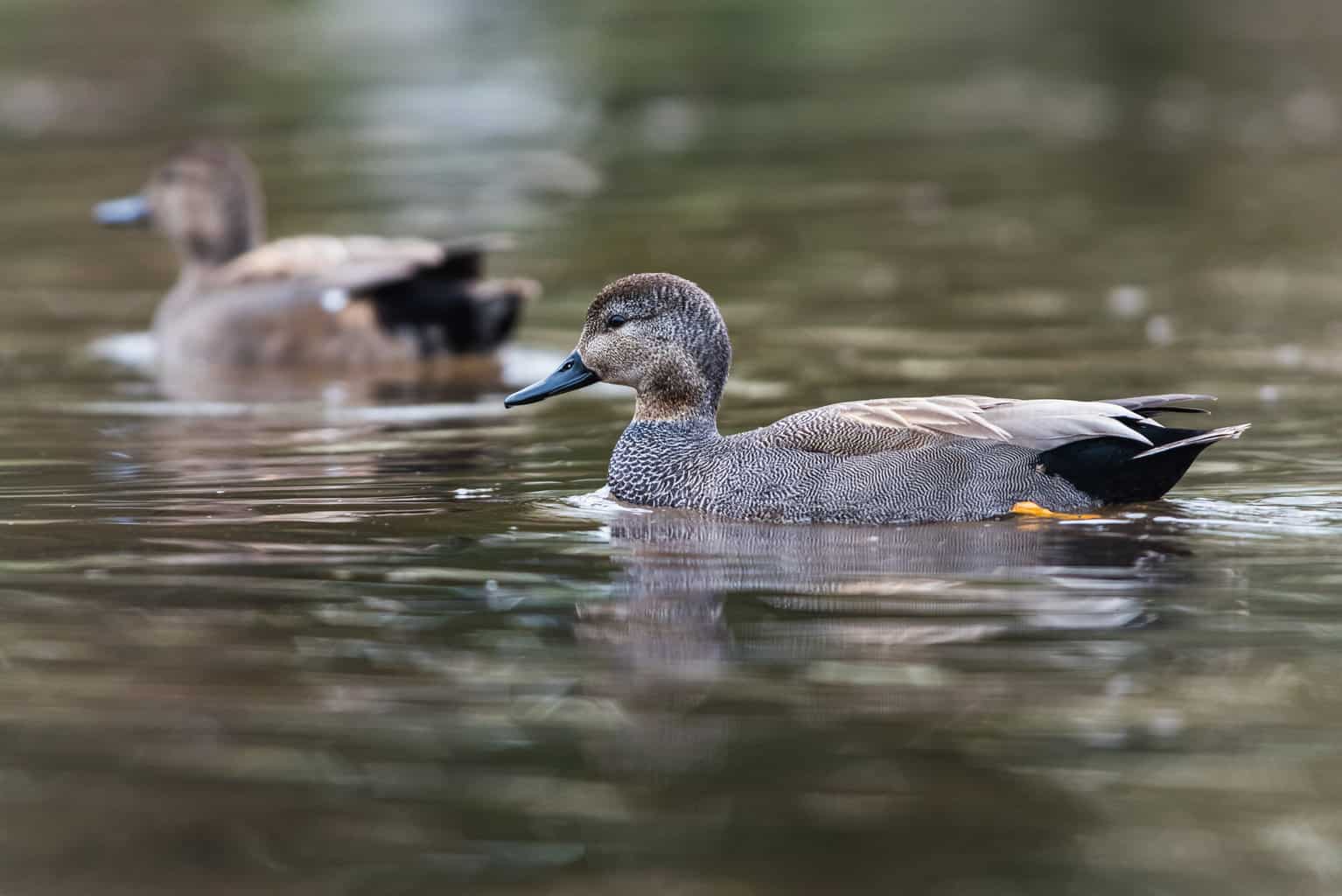
- Mareca strepera
- Length: 18.1-22.4 inches
- Weight: 17.6-44.1 ounces
- Wingspan: 33.1 inches
Male gadwall have gray-brown bodies. From the neck upwards, they’re a light brown before finishing off with a sleek black bill.
The female gadwall is tough to distinguish from females of species like mallards. The Cornell Lab of Ornithology says that gadwall females have a thinner, darker bill, but without a reference point to a mallard, this can be very difficult to see while afield.
If you see one in flight, you might get a clue as to a gadwall’s identity, as they have a white wing patch as opposed to the colored patch of a mallard.
Gadwall are a non-breeding Louisiana species. They breed largely west of the Rockies, with sporadic breeding in other areas such as around the Great Lakes.
Look for them in coastal wetlands. eBirders frequently report them at areas like Sabine National Wildlife Refuge and Cameron Prairie National Wildlife Refuge.
Blue-winged Teal
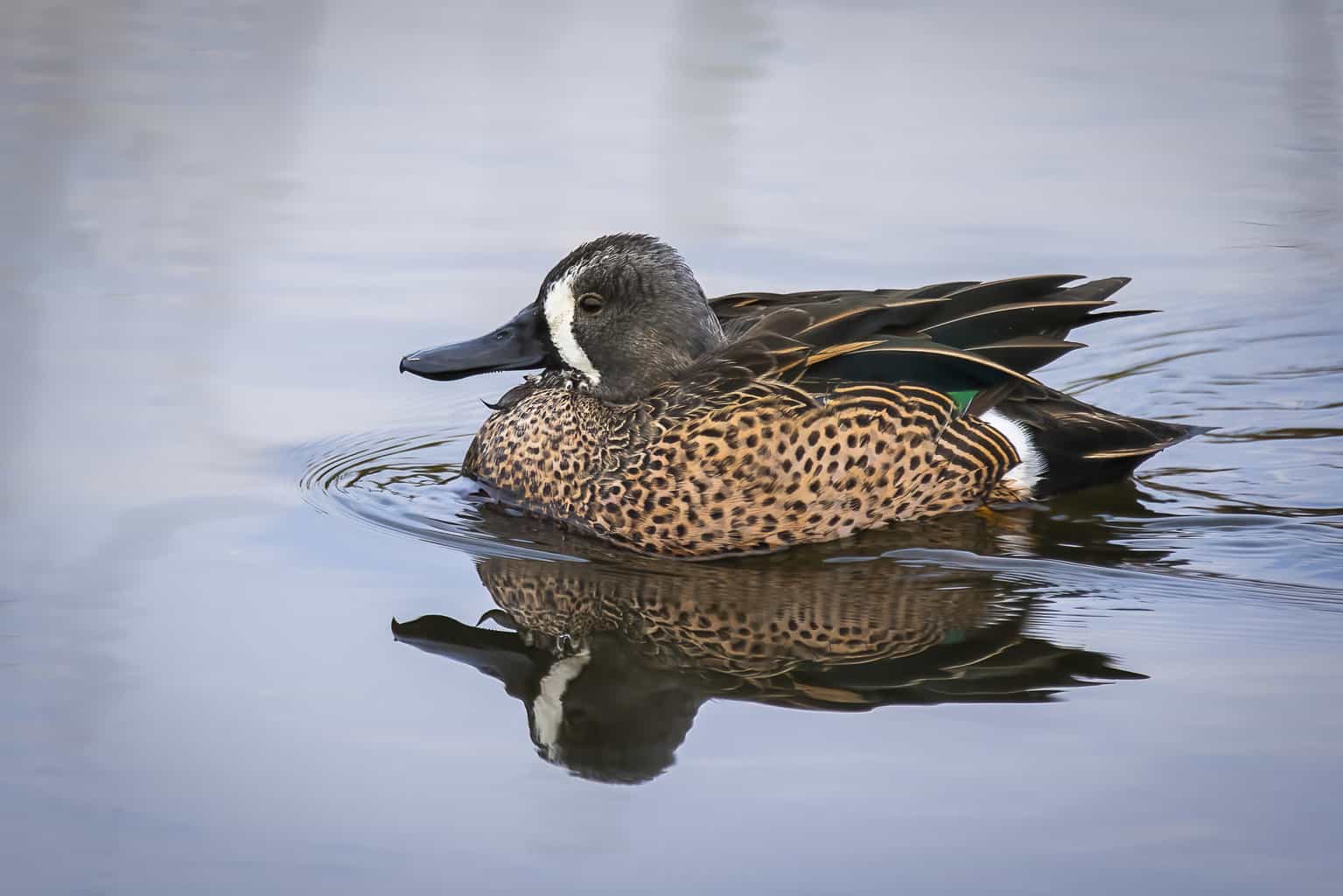
- Spatula discors
- Length: 14.2-16.1 inches
- Weight: 8.1-19.2 ounces
- Wingspan: 22.1-24.4 inches
While blue-winged teals mainly breed in northern habitats, some do spend the entire year in marshes by Louisiana’s coast.
Blue-winged teals have slate-colored heads with a white strip that separates their eyes from their black-colored bills.
They have speckled brown sides and black backs, along with green, white, and powder blue wing patches when in flight.
Females also show off those powder blue patches when in flight. They have brown patterned bodies like other dabbling ducks, with black bills.
Green-winged Teal
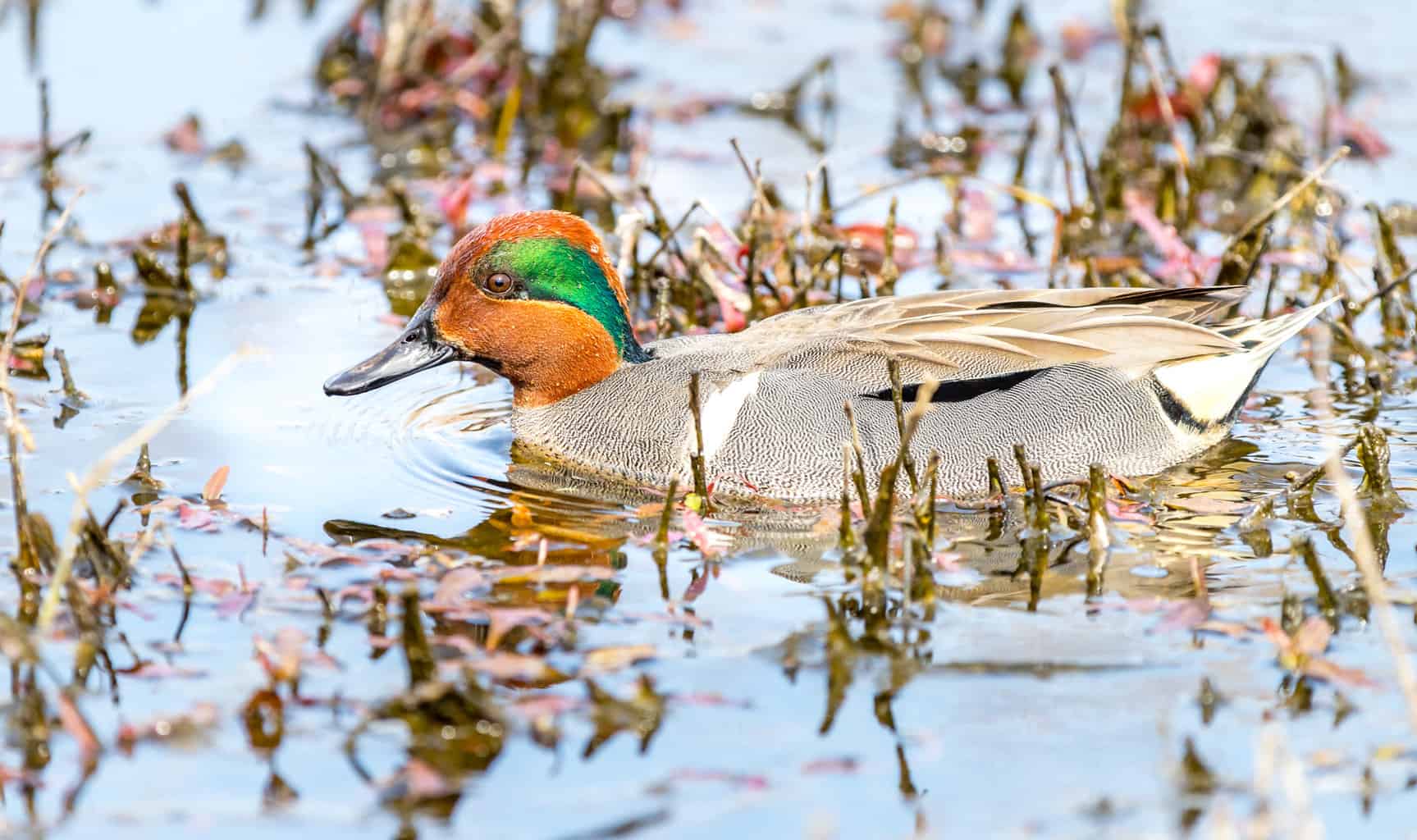
- Anas crecca
- Length: 12.2-15.3 inches
- Weight: 4.9-17.6 ounces
- Wingspan: 20.5-23.2 inches
The green-winged teal is one of North America’s smallest ducks and another non-breeding visitor to Louisiana.
Green-winged teals breed along ponds and lakes near boreal forests or the shallow ponds of the Great Plains, neither of which Louisiana provides.
Male green-winged teals have beautiful chestnut-brown heads split by rich green patches around the eye that loop back toward the rear of their heads.
Females don’t look much different than other female dabbling ducks like the mallard and gadwall, save for their small stature.
The green wing patches of both sexes, like with the blue-winged teal, are most easily visible when in flight.
Green-winged teals spend their summers up north, stopping along the way in ponds and shallow wetlands across the country.
Look for them in Louisiana during migration and non-breeding seasons.
American Wigeon

- Mareca americana
- Length: 16.5-23.2 inches
- Weight: 19.1-46.9 ounces
- Wingspan: 33.1 inches
Take the green head patch of the male green-winged teal and replace the rich brown head with a gray throat and face, a lightly-colored beak, and a white crown and you’ve got a male American wigeon.
The wigeon is also bigger, of course.
Females have tan bodies and gray-ish heads, with dark patches around their eyes that make them appear sunken in. Their light gray bills are tipped in black.
Wigeons mainly breed in the northern Rockies up through Canada and Alaska and spend their winters south of the Great Plains.
Your best bet to see wigeons in Louisiana is when they show up at wintering grounds near the coast.
Northern Pintail
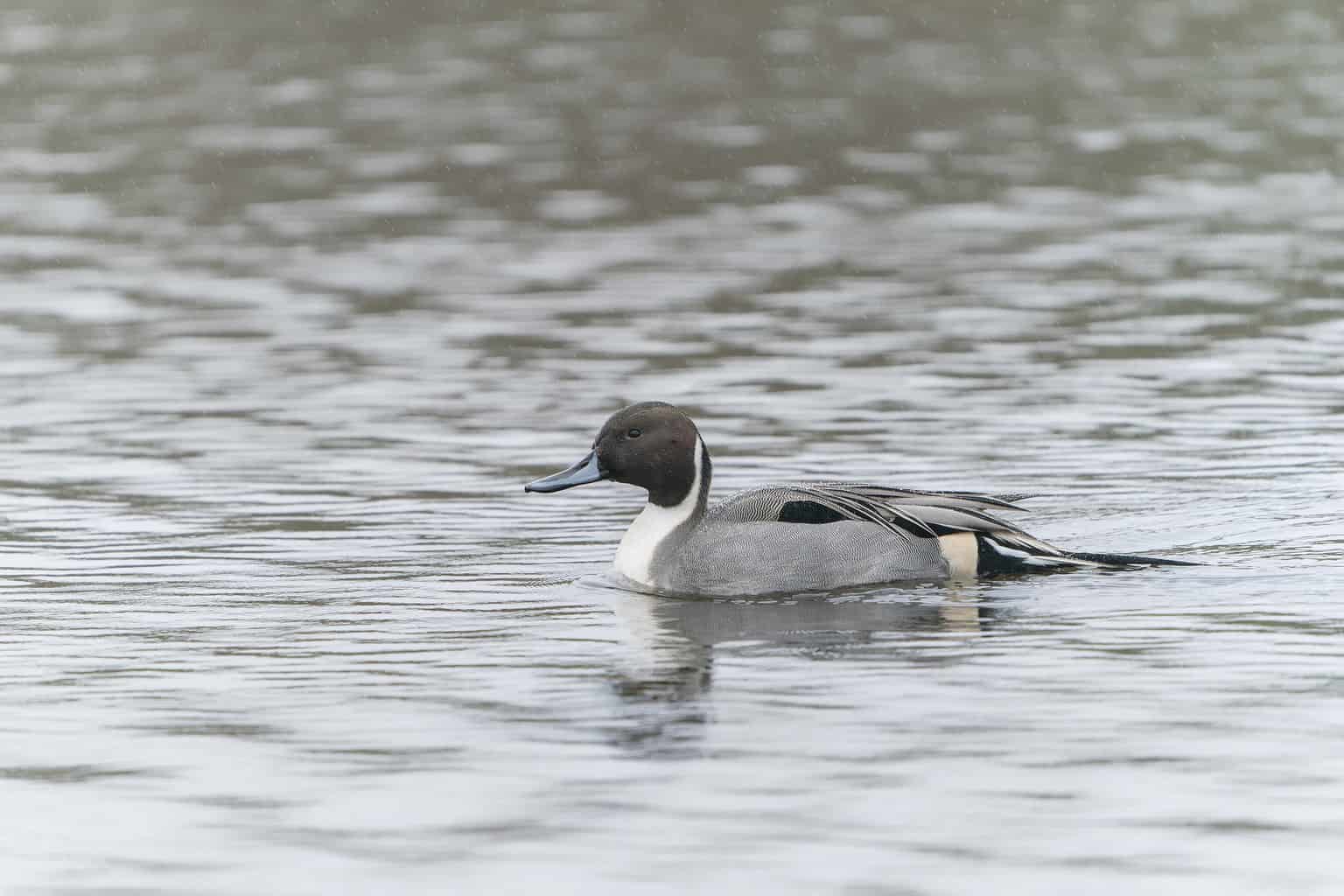
- Anas acuta
- Length: 20.1-29.9 inches
- Weight: 17.6-51.1 ounces
- Wingspan: 34 inches
The northern pintail’s long black tail is rivaled in North America perhaps only by the northern long-tailed duck, which is not found in Louisiana.
Male pintails are striking birds with long, white necks that meet a crisp brown head at the throat and a light gray body at the sides.
It’s hard to miss a male pintail in the field. Females still have a proportionately longer tail than many other birds on the list, but it’s not as recognizable as the male’s.
Their neck is also noticeably longer than ducks like the mallard, gadwall, or American black duck.
Pintails breed much further north than Louisiana, so keep an eye out during the non-breeding season in marshes, flooded fields, and lakes like those found in coastal wildlife refuges.
Northern Shoveler
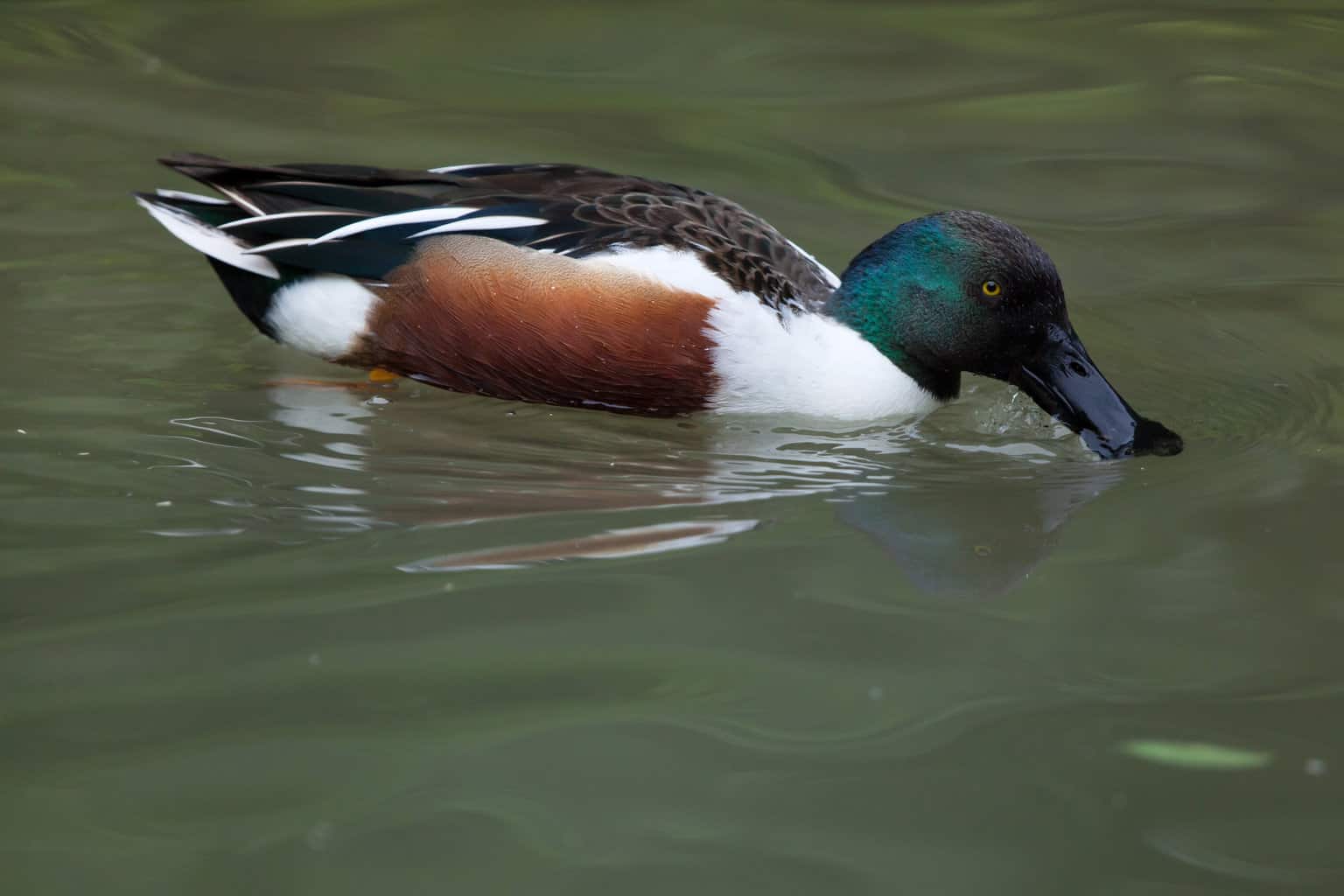
- Spatula clypeata
- Length: 17.3-20.1 inches
- Weight: 14.1-28.9 ounces
- Wingspan: 27.2-33.1 inches
It’s not difficult to identify a northern shoveler in the field if you can see its bill. A striking black on males and light orange on females, the northern shoveler’s disproportionately large bill sticks out like a sore thumb.
Male northern shovelers have a green head similar to a mallard, but their black bill is far larger. Look for the rusty brown underside and against a white body as well when identifying a male shoveler.
Female shovelers have a similar color to mallard females as well, with an orange and black bill, although that big bill is still the standout.
You’ll usually find shovelers in marshes and wetlands, using those large bills to find food.
Like many other species on this list, the coastal Louisiana wetlands can be hotspots for shovelers.
Ducks That Dive
Redhead
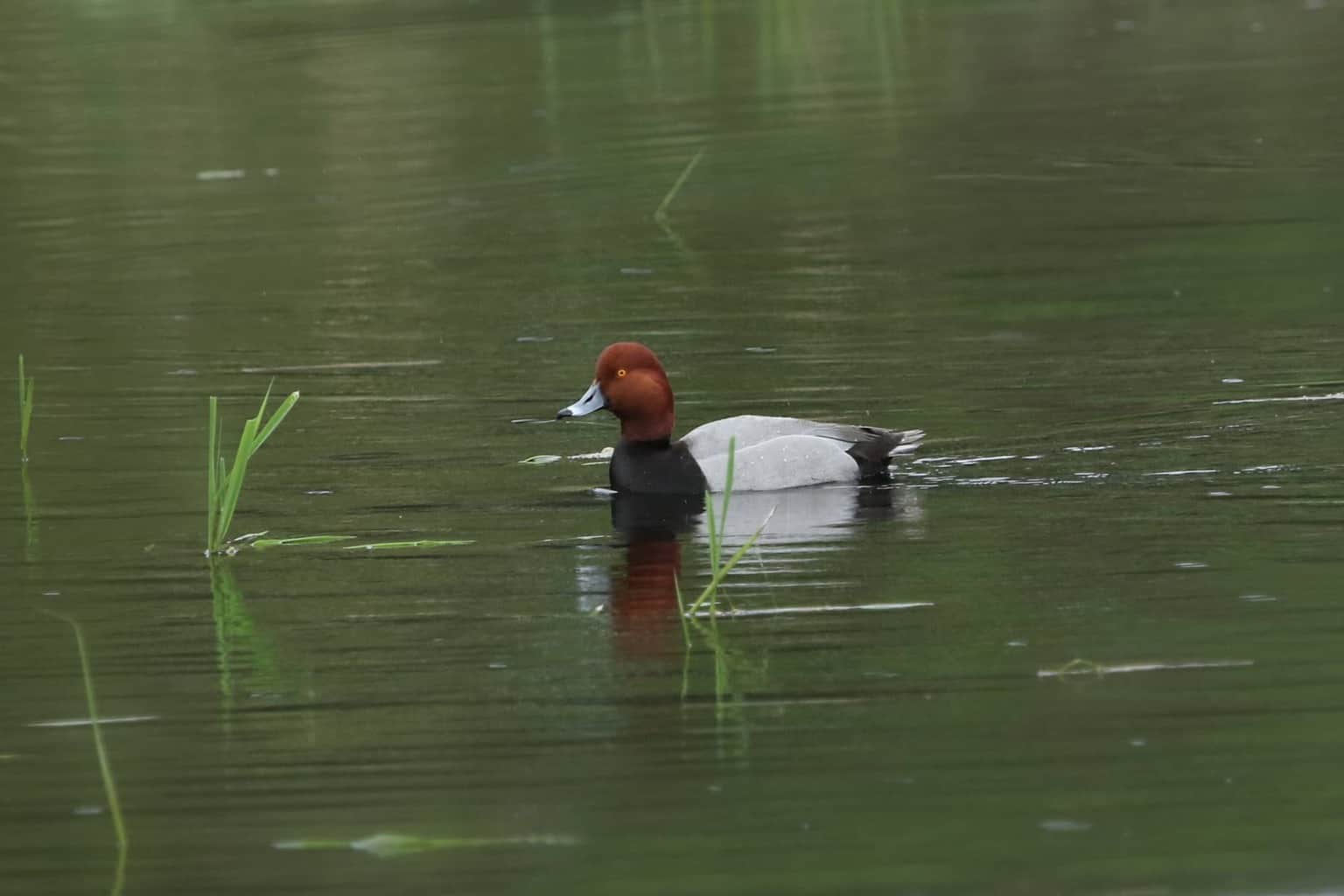
- Aythya americana
- Length: 16.5-21.3 inches
- Weight: 22.2-52.9 ounces
- Wingspan: 29.5-31.1 inches
Redhead males have striking red heads, black chests, and bodies colored mostly light gray.
Their gray bill is capped in black. Notably, red-headed ducks have a steep forehead and rounded back of the head, which is an important distinction when comparing them to canvasbacks.
Female redheads do not have the male’s signature look. Instead, they have a light brown body with a slightly darker brown head and a gray, black-tipped bill.
Redheads are an uncommon sighting in Louisiana for eBird users.
Canvasback
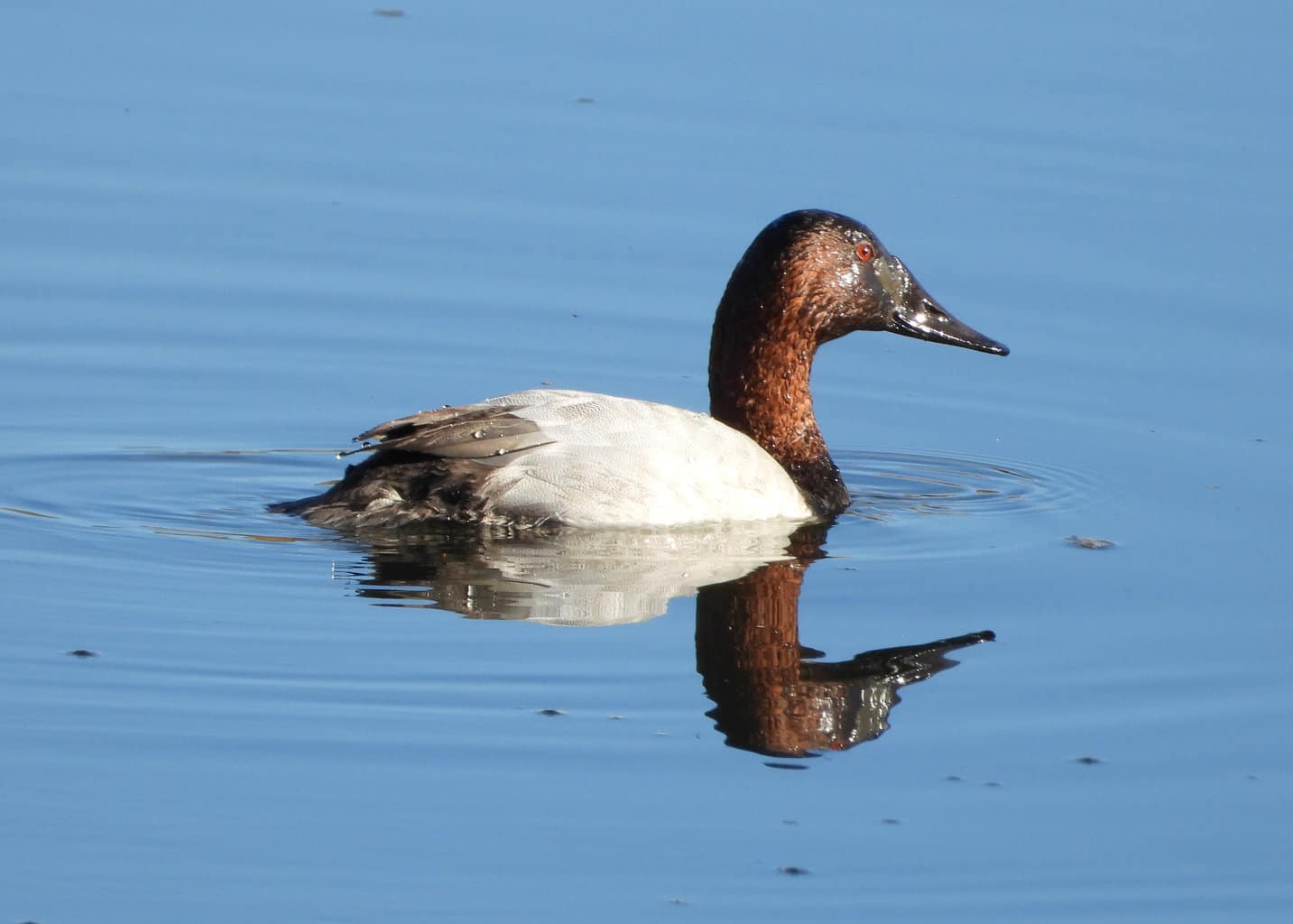
- Aythya valisineria
- Length: 18-9-22.1 inches
- Weight: 30.4-56 ounces
- Wingspan: 31.1-35 inches
Before we get to the canvasback’s head shape, let’s touch on its coloring.
Male canvasbacks have a similar head, chest, and tail color to male redheads, but with a white back and sides where the redhead is gray.
Female canvasbacks have a similar pattern to males, just with more muted colors. They don’t have red heads, instead displaying a pale brown head, light gray sides and backs, and muted grays and browns covering the rest of the body.
Going back to this bird’s head shape, canvasbacks have a gradually sloping forehead that meets a slender black bill. Redheads, on the other hand, have a steeper forehead and a more rounded back of the head.
Canvasbacks mostly breed up through the northwestern United States, Canada, and Alaska. Look for them in coastal waters.
Greater Scaup
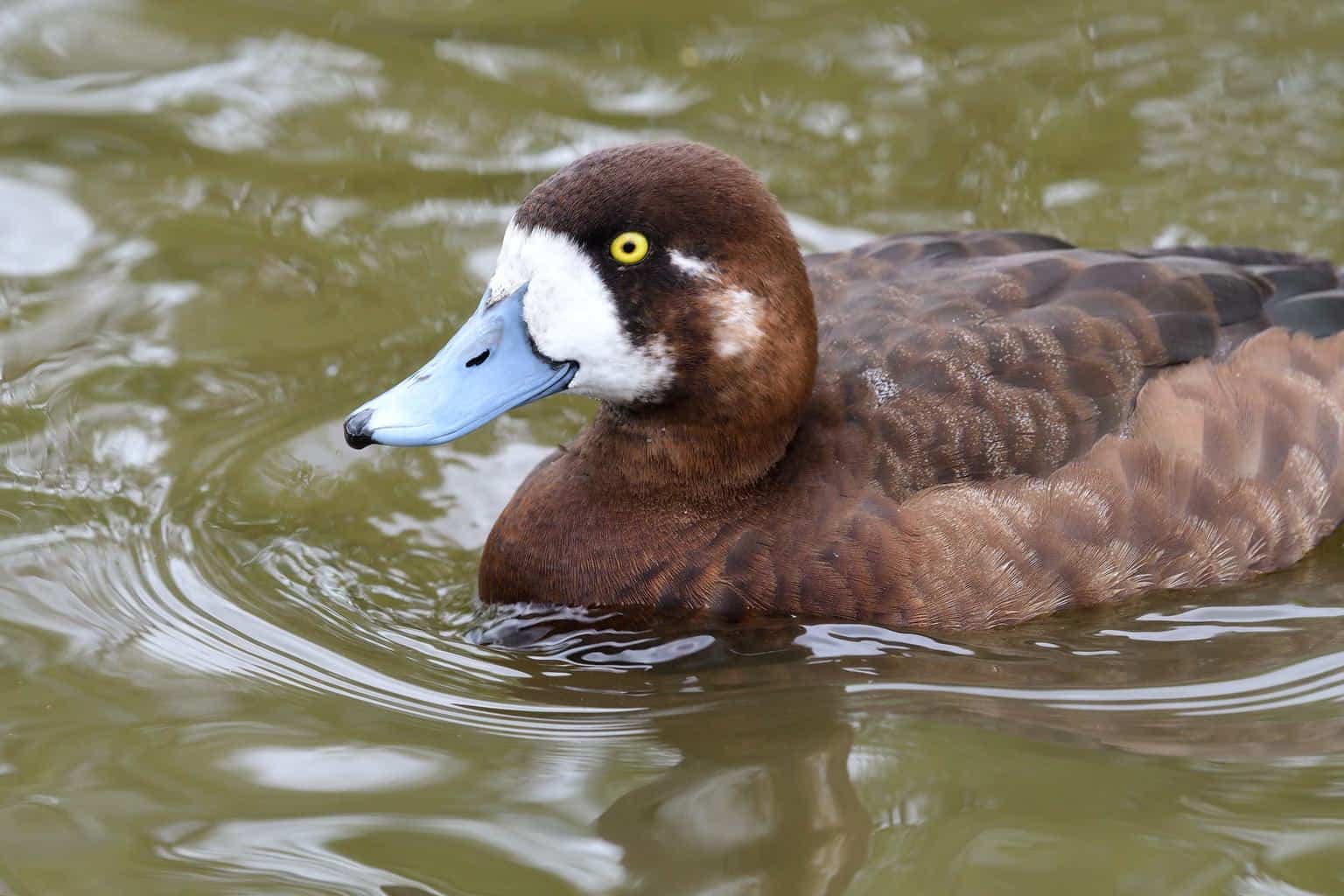
- Aythya marila
- Length: 15.3-22.1 inches
- Weight: 25.6-48 ounces
- Wingspan: 28.4-31.1 inches
Most greater scaup spend their breeding season in the northernmost stretches of Canada, then travel south for winter, though ‘south’ means southern Canada to some and the Gulf Coast for others.
Despite this, greater scaup are not a frequent sighting for most residents of the Pelican state.
Male greater scaup have black heads that may appear green in good lighting. A black neck connects with a white side and gray back.
Females are brown with a large white patch surrounding the base of their gray bills. Both males and females have yellow eyes.
Lesser Scaup
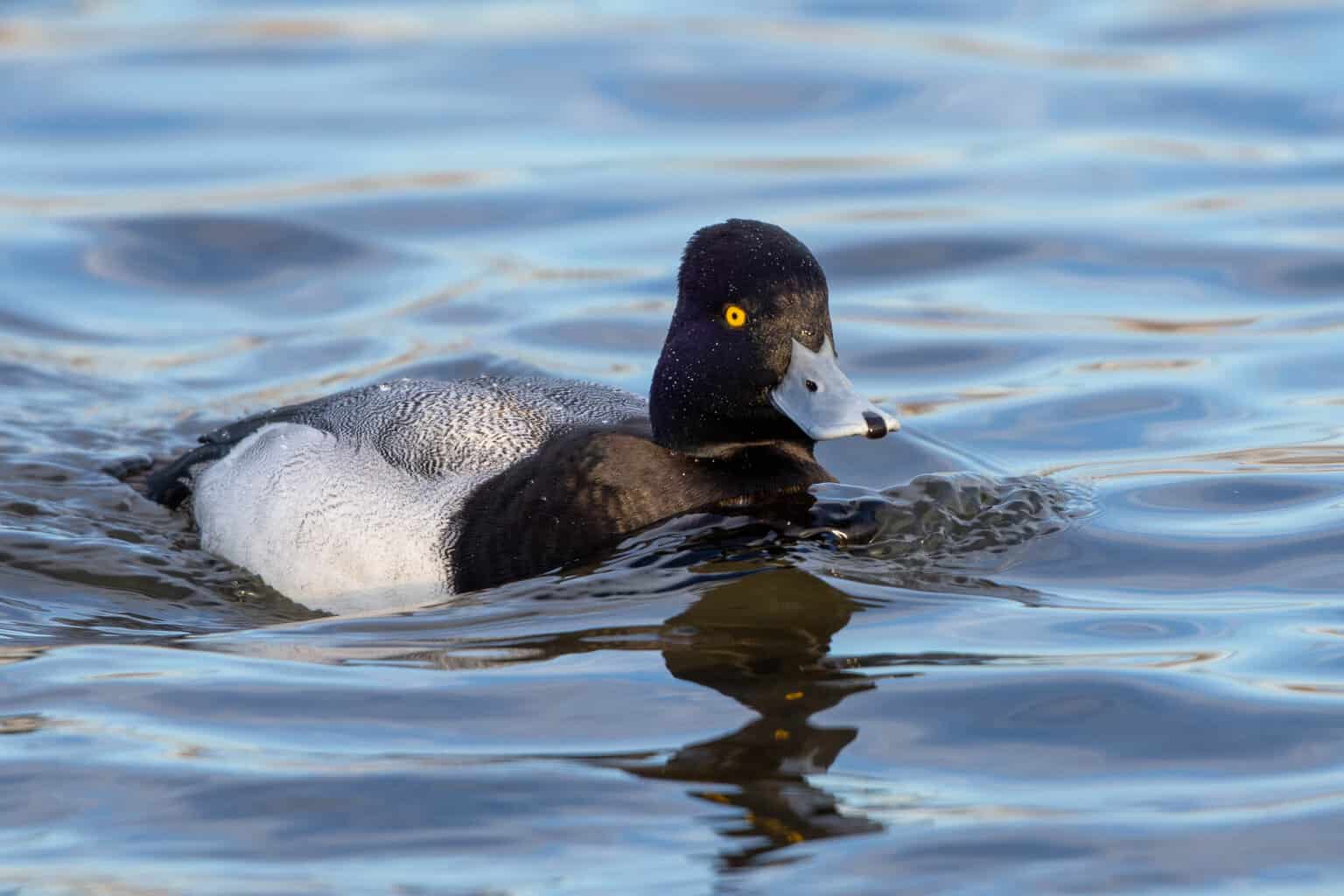
- Aythya affinis
- Length: 15.3-18.1 inches
- Weight: 16-38.4 ounces
- Wingspan: 26.8-30.7 inches
Both sexes of lesser and greater scaup can be difficult birds to distinguish while in the field.
Females are set apart by their color. Lesser scaup are a darker, chocolate brown compared to the greater scaup’s generally lighter tint.
Lesser scaup are typically smaller than greater scaup, as their name implies. They also have a less rounded head.
The back of a lesser scaup’s head slopes vertically downward compared to the greater scaup’s more rounded head.
You might find it difficult to tell the slope of a bird’s head while afield, so a spotting scope or a photo might help you correctly identify this species.
Lesser scaup breed in areas a bit further south than greater scaup, but not quite as far south as Louisiana. You could see them throughout the state in their winter flocks, including marshes near the coast.
Ring-necked Duck
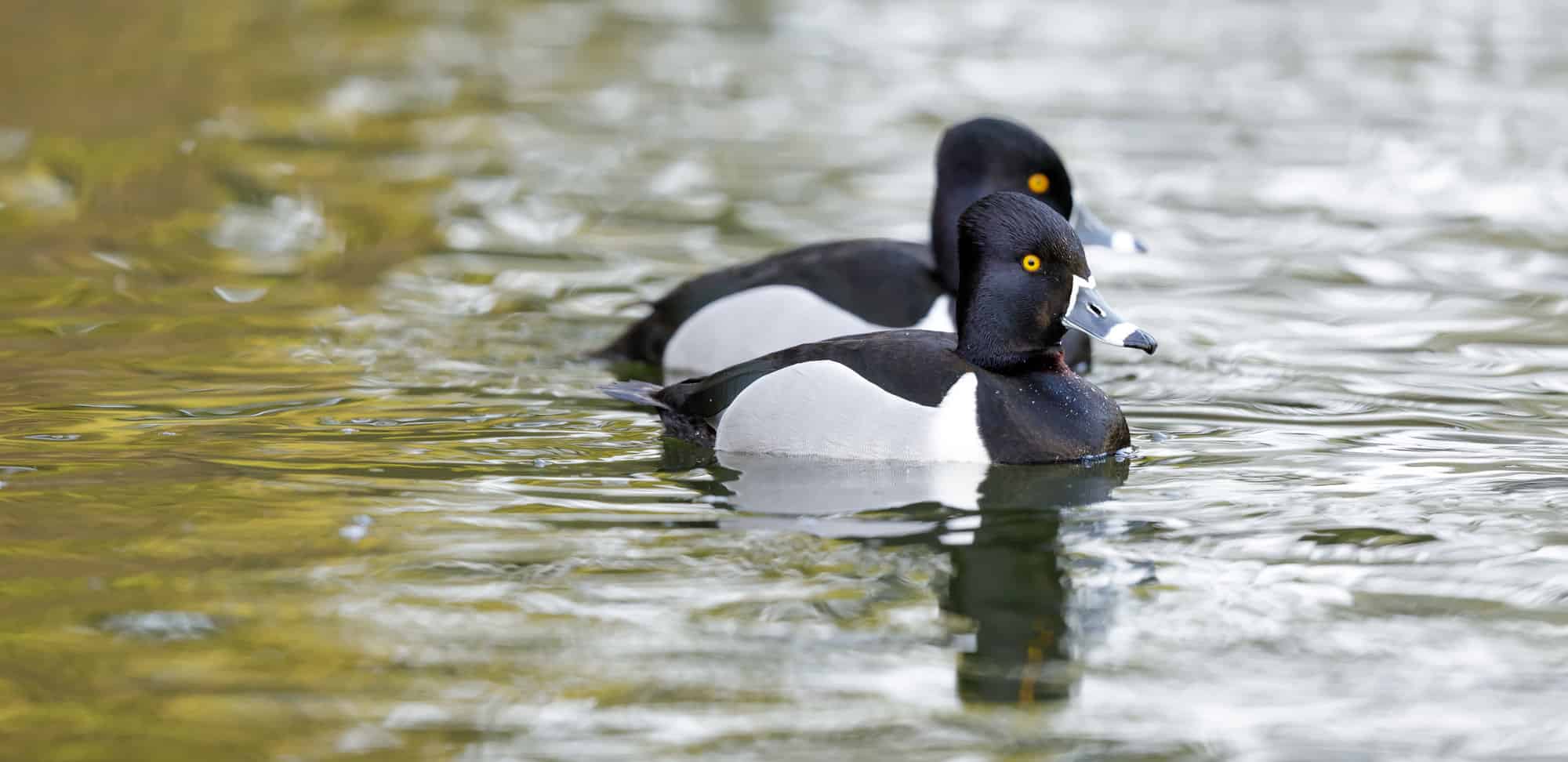
- Aythya collaris
- Length: 15.3-18.1 inches
- Weight: 17.3-32.1 ounces
- Wingspan: 24.4-24.8 inches
You may be starting to sense a theme. The ring-necked duck is another on our list of Louisiana ducks spending only the non-breeding season in the state.
Ring-necked duck males look quite similar to scaup, but have a black back instead of the scaup’s gray backs.
Ring-necked males and brown-bodied females also have a unique bill that features two white rings. One is closer to the base of the bill and the other is near the tip.
Look for them in ponds, rivers, or lakes during the winter months.
Black Scoter
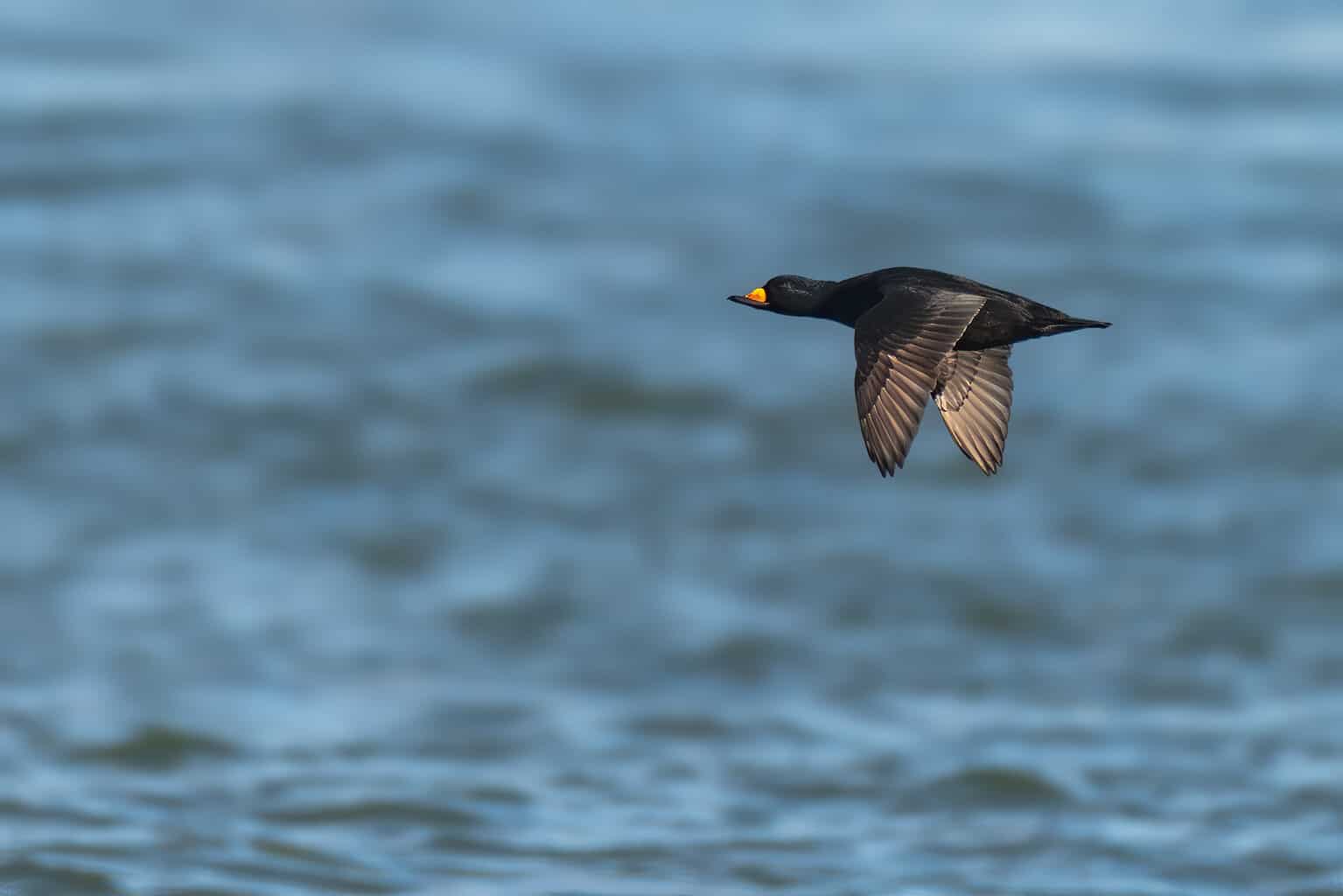
- Melanitta americana
- Length: 16.9-19.3 inches
- Weight: 30.4-38.8 ounces
- Wingspan: 27.6-28.4 inches
The first of three scoters on our Louisiana list is the black scoter.
Male black scoters are jet black from their tails to their bills, save for a bright orange patch on top of their bills.
Females have brown bodies and brown caps, separated by light faces and black bills.
These birds breed in the far northern stretches of North America but may winter along the Gulf, in addition to other coastal waters along the Atlantic and Pacific coasts.
Most eBird reports of black scoters come from coastal regions in western Louisiana.
Surf Scoter
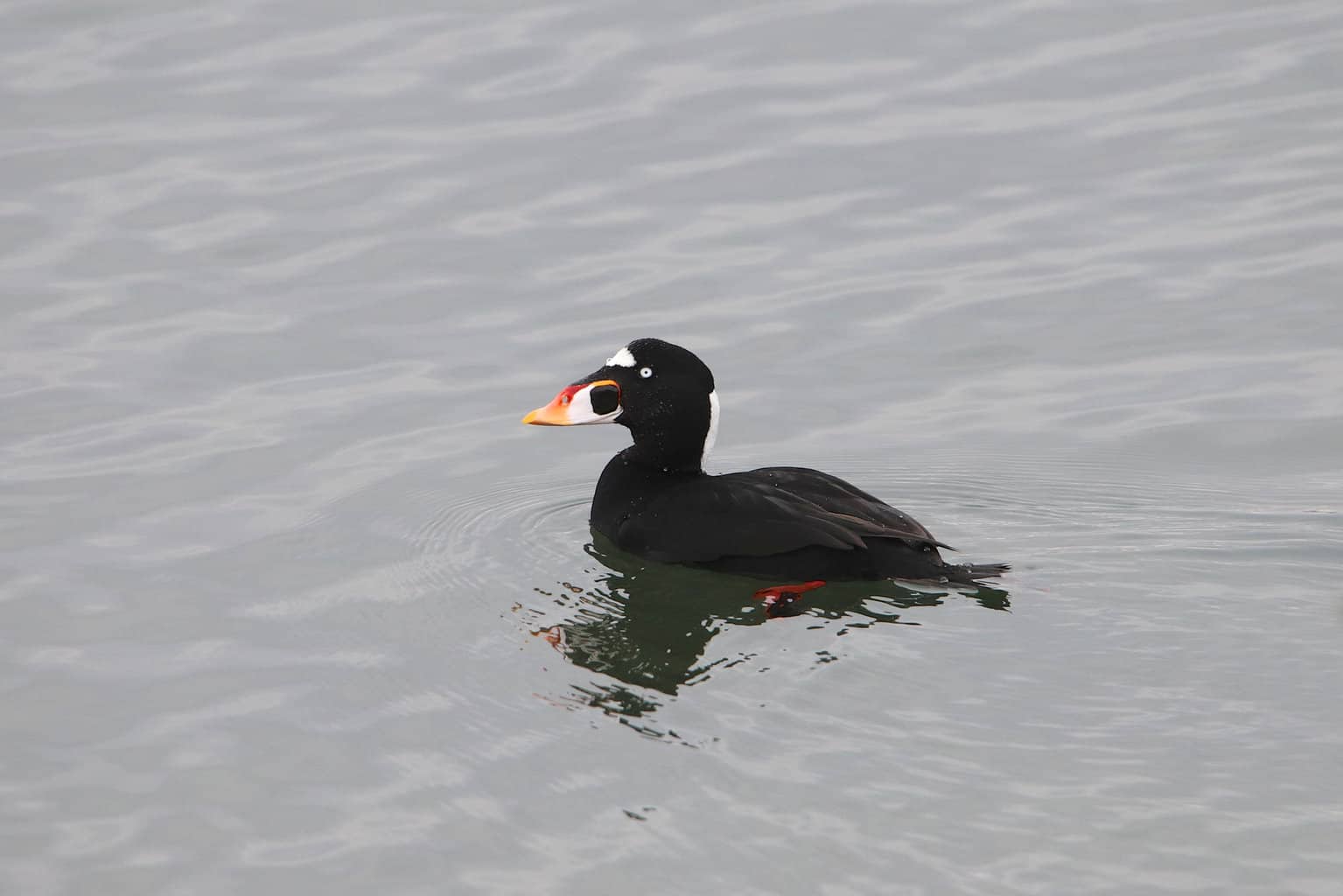
- Melanitta perspicillata
- Length: 18.9-23.6 inches
- Weight: 31.8-45.6 ounces
- Wingspan: 29.9-30.3 inches
Surf scoters follow a similar migration pattern to black scoters, moving from the far north to the coasts and gulf for the winter.
Males also have jet-black bodies, but their head and neck areas have a bit more variety than the black scoter.
They have large orange bills with white patches on their heads, napes, and along the bill, along with pale white eyes.
Females have large black beaks with brown bodies and white facial patches.
Surf scoters are a rare spot in Louisiana. Like black scoters, your best bet is along the western coast.
White-winged Scoter
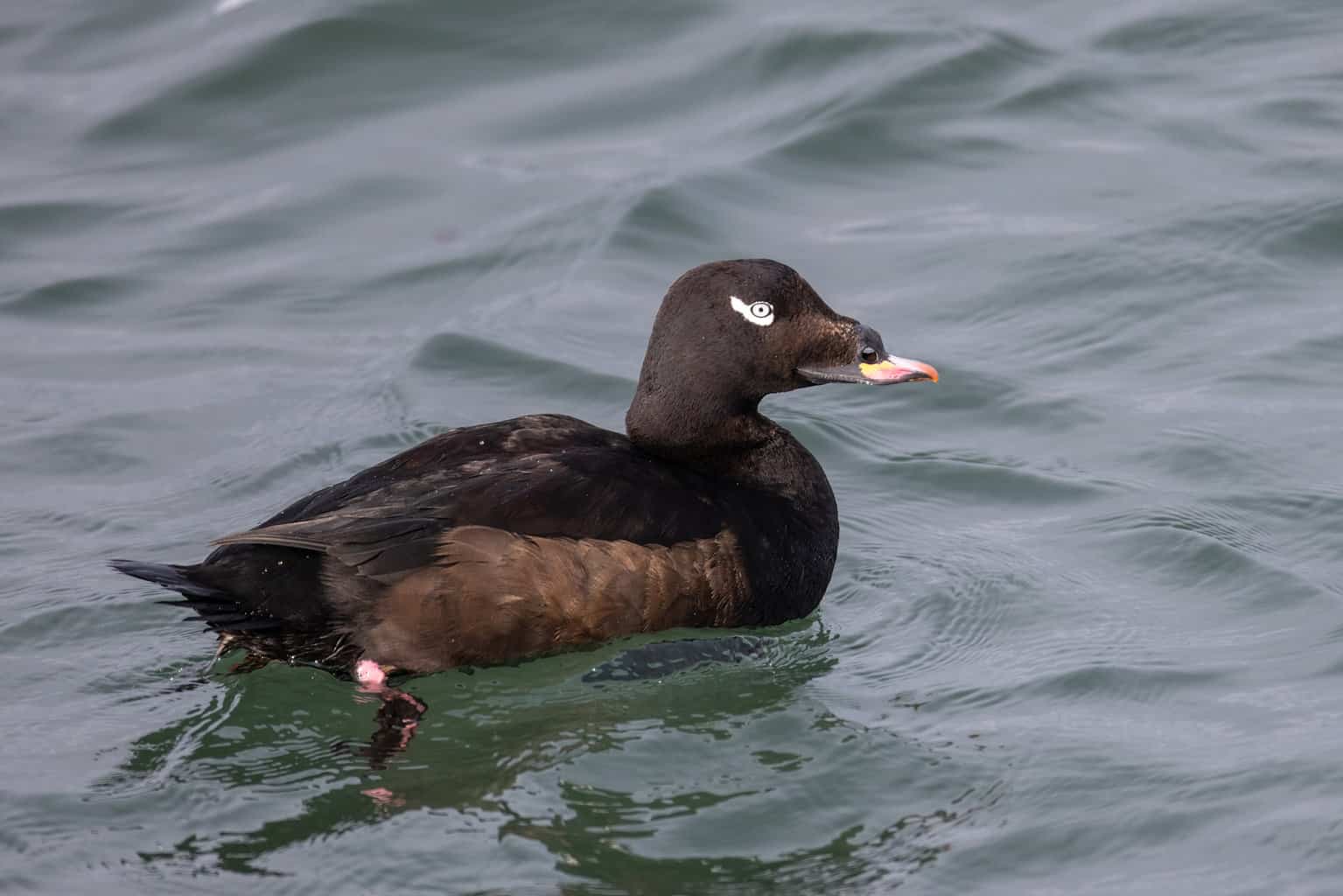
- Melanitta deglandi
- Length: 18.9-22.8 inches
- Weight: 33.5-63.5 ounces
- Wingspan: 31.5 inches
The white-winged scoter winters along the coast from Canada and Alaska down to the Gulf Coast, where you could catch a glimpse of one in the Pelican State.
They’re roughly the size of surf scoters and a bit larger than black scoters. Males have a white eye surrounded by a thin white circle and an orange beak topped by a black knob.
Females look similar to female surf scoters. Look for a white wing patch on female white-winged scoters that the often darker surf scoters lack.
White-winged scoters are uncommon sightings. Look in coastal waters such as those near the Texas border.
Common Goldeneye
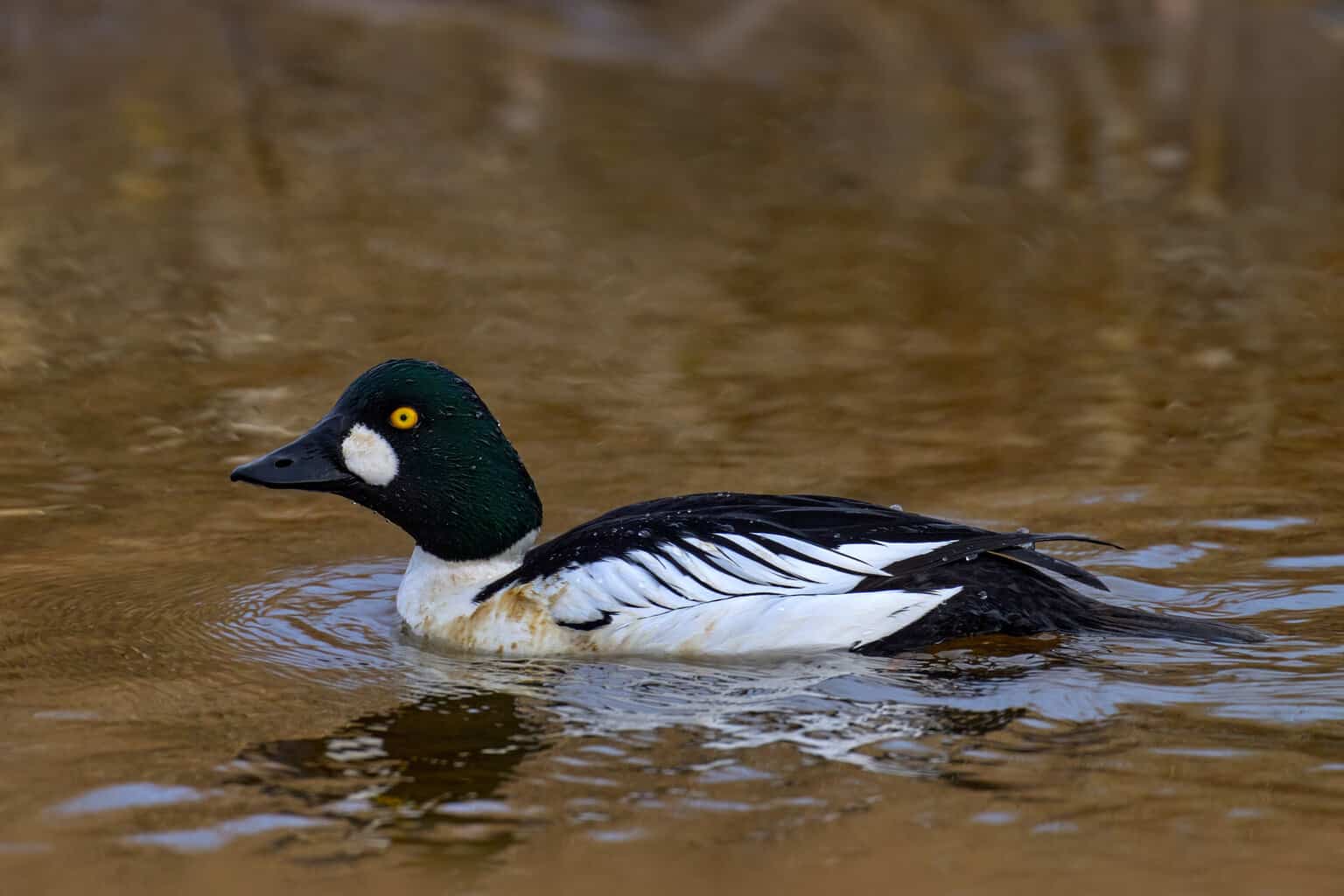
- Bucephala clangula
- Length: 15.8-20.1 inches
- Weight: 21.2-45.9 ounces
- Wingspan: 30.3-32.7 inches
Males have an iridescent green head with an oval-shaped white patch near a black bill. A white neck and underside meet a black topside with a white slotted side.
Both males and females have the namesake golden eye. Females have brown heads and gray bodies. When in flight, you may be able to see their orange feet and white wing coloration.
There is another goldeneye species, Barrow’s goldeneye, but if you’re seeing one in Louisiana, it’s almost certainly a common goldeneye.
Some of the common areas to see goldeneyes are near lakes and rivers around the New Orleans area, according to eBird reports.
Bufflehead
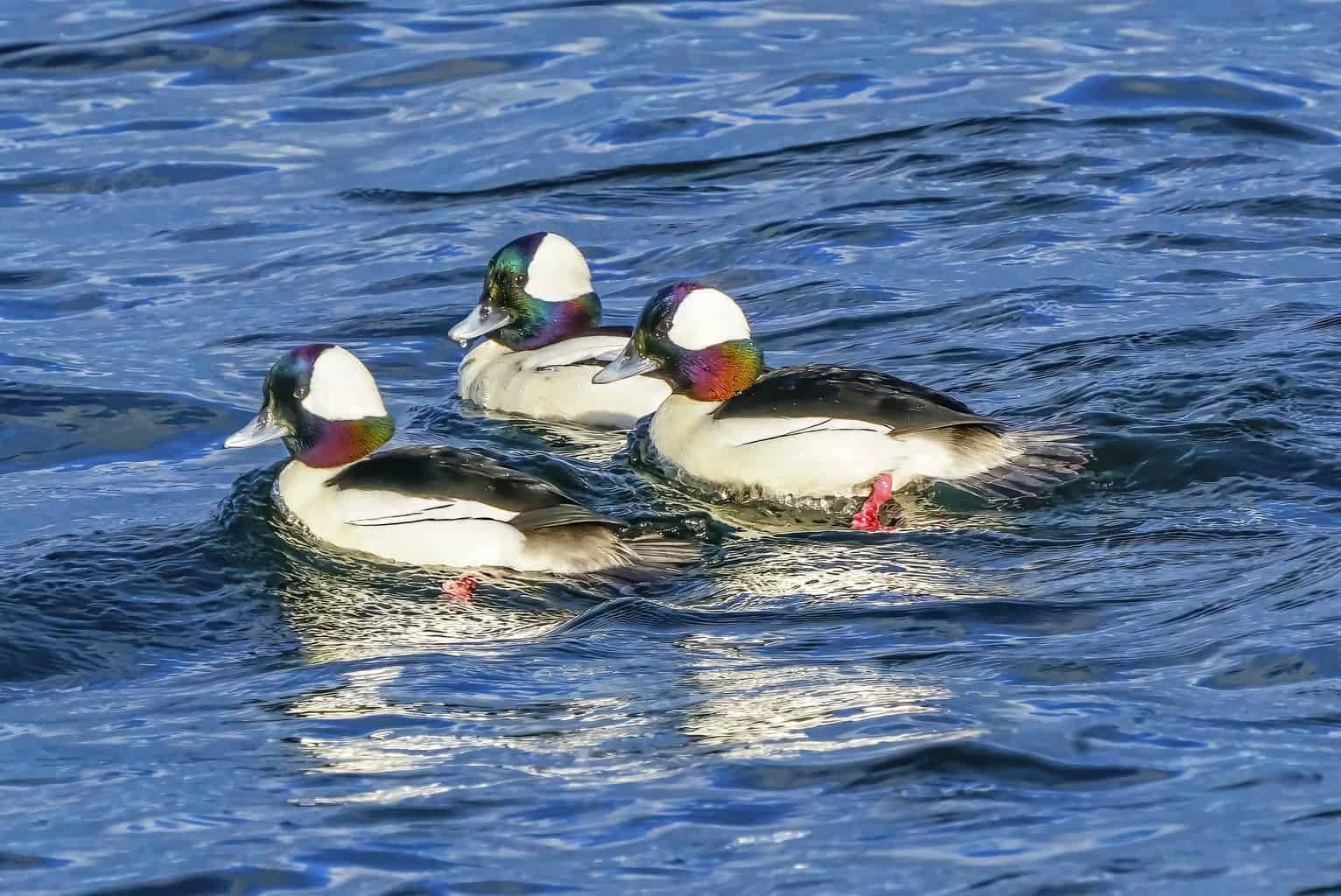
- Bucephala albeola
- Length: 12.6-15.8 inches
- Weight: 9.6-22.4 ounces
- Wingspan: 21.6 inches
The tiny diving bufflehead male can be identified by the large white patch that takes up over a quarter of its head.
The rest of the male’s head is an iridescent black that may appear green or violet depending on the lighting. A black back and white sides give it a striking appearance, even from afar.
Females and immature males have slightly more muted colors and white patches off to the side of their eyes.
The only duck with a white patch that rivals the male bufflehead is perhaps the hooded merganser, which has a long, thin, black bill, brown sides, and a big crest on the back of the head that makes them look almost disproportionate.
Female hooded mergansers have a similarly-shaped crest to the males but without the white coloring. They do not have a white facial patch like female buffleheads.
Buffleheads breed in northern forestlands, but in winter, they prefer open spaces such as saltwater coasts and large lakes.
Birders on eBird commonly report them around New Orleans along Lake Pontchartrain and Bayou Sauvage National Wildlife Refuge, among other areas.
Ruddy Duck
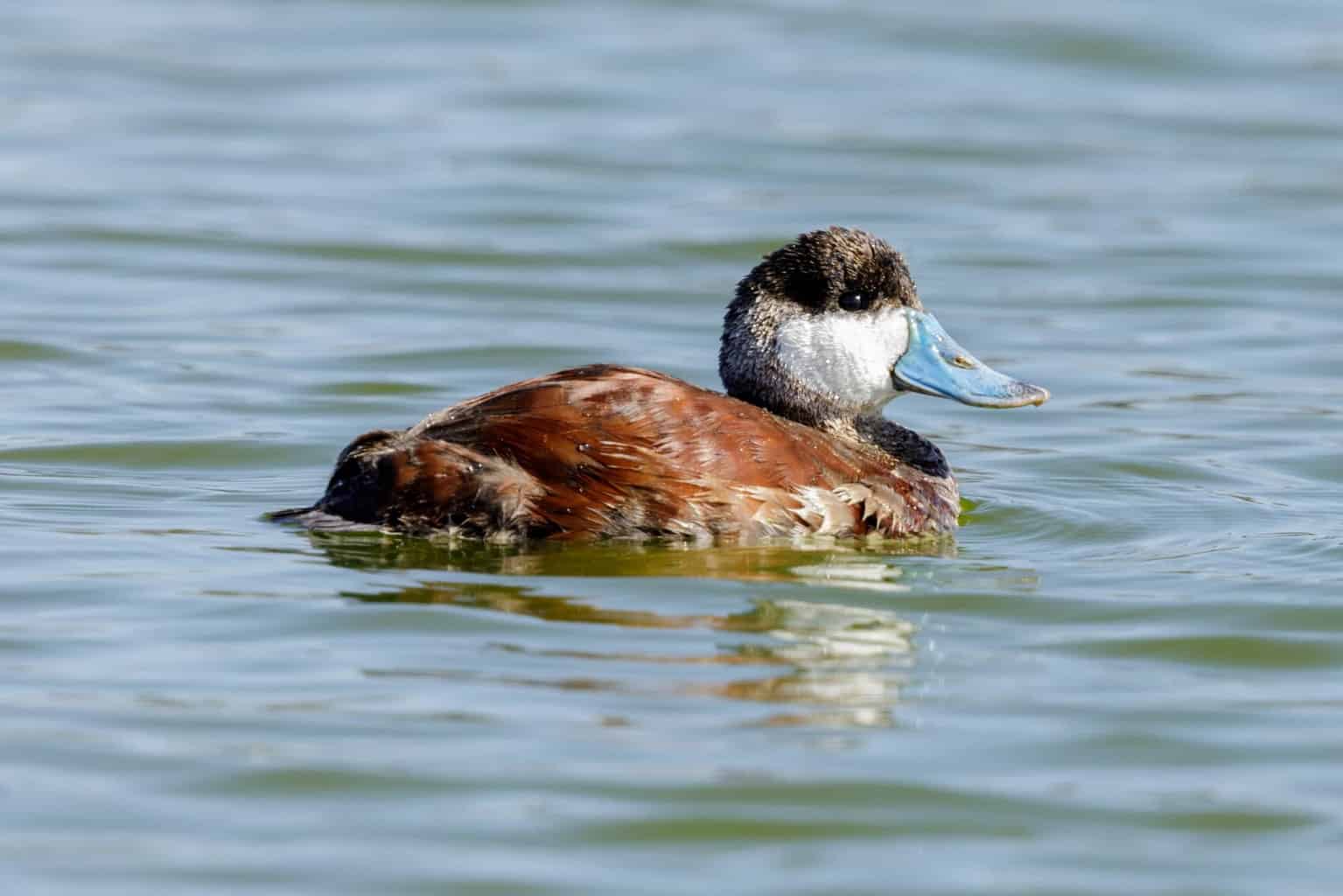
- Oxyura jamaicensis
- Length: 13.8-16.9 inches
- Weight: 10.6-30 ounces
- Wingspan: 22.1-24.4 inches
Male ruddy ducks’ baby blue bills are a unique feature that sets them apart from others.
The top of a male ruddy duck’s head is black, with white cheeks and a light nape and neck that meets a warm brown body that caps in a long, nearly vertical tail.
Female ruddy ducks sport black bills with lighter brown bodies. Their head cap is a darker brown, with a horizontal parallel streak of darker color running just below the eye.
Ruddy ducks are more concentrated along the coasts and sporadic across the rest of the state. You will likely have more luck seeing one in Louisiana during the winter.
Red-breasted Merganser
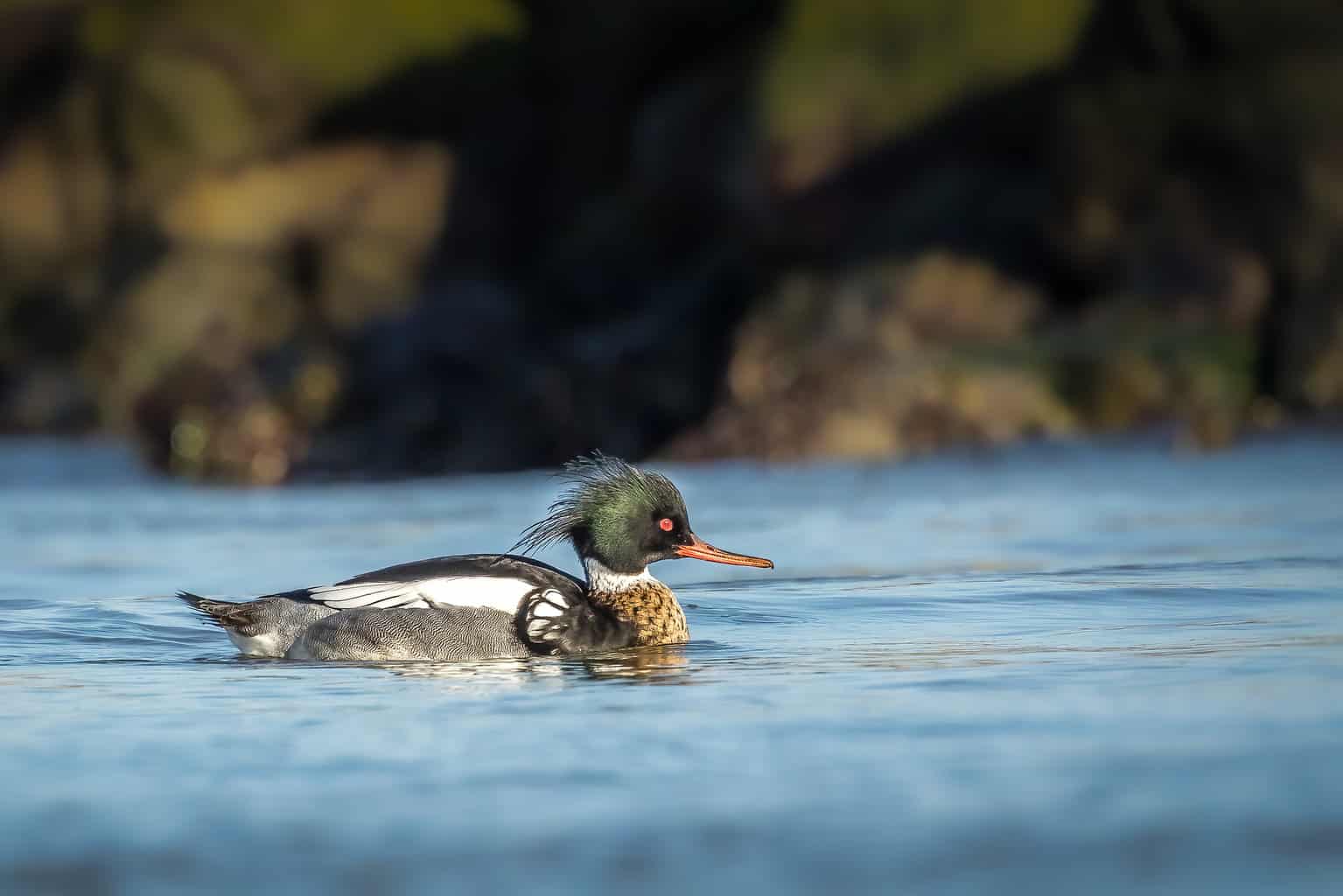
- Mergus serrator
- Length: 20.1-25.2 inches
- Weight: 28.2-47.6 ounces
- Wingspan: 26-29.1 inches
Male red-breasted mergansers have a black head and a brown breast. Their spiky, black top of the head also distinguishes them from the common merganser male, which isn’t typically seen in Louisiana, anyway.
Red-breasted mergansers breed in the far north and spend their non-breeding season along the coasts, from the Pacific to the Atlantic. Their non-breeding range includes Louisiana’s Gulf Coast.
They’re not usually spotted in huge groups like some other coastal ducks, so sightings are spread out and fairly infrequent in the Pelican State.
Birders at eBird more commonly spot red-breasted mergansers along the Gulf sides of states like Florida and Alabama.
Hooded Merganser
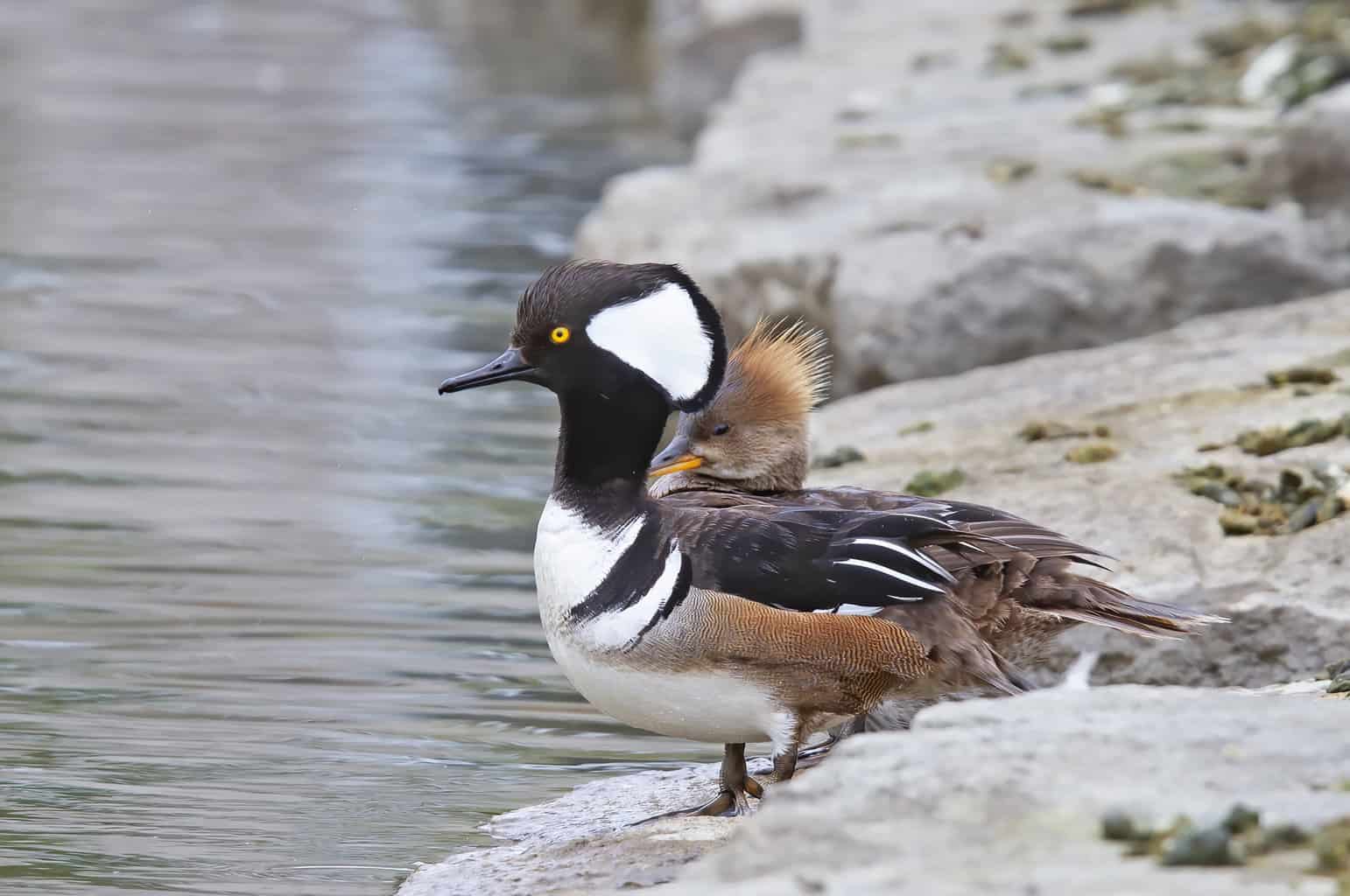
- Lophodytes cucullatus
- Length: 15-8.-19.3 inches
- Weight: 16-31 ounces
- Wingspan: 23.6-26 inches
This bird is the only member of its genus. According to iNaturalist, the name is derived from the Greek words lophos, for ‘crest,’ and dutes, meaning ‘diver.’
They’re generally noticeably smaller than the two other mergansers we’ve mentioned, but the head certainly doesn’t lack for size.
The male’s black crested head is interrupted by a big white patch. Their sides are brown with black backsides and white chests. Males have yellow eyes.
Females have a crested head, except brown and without the male’s standout white patch. Their bodies are a more grayish-brown mix and they do not have yellow eyes like males do.
Hooded mergansers are spread across their range and usually found in small groups. They may spend all year in Louisiana.
Hooded mergansers are cavity nesters, meaning they nest in holes in trees. During the breeding season, look on lakes or ponds with trees nearby and plenty of fish and crayfish to eat.

